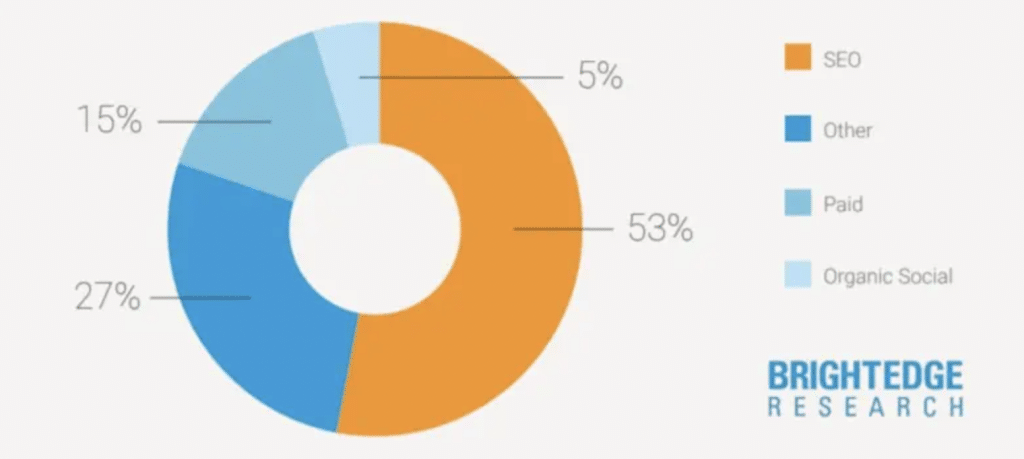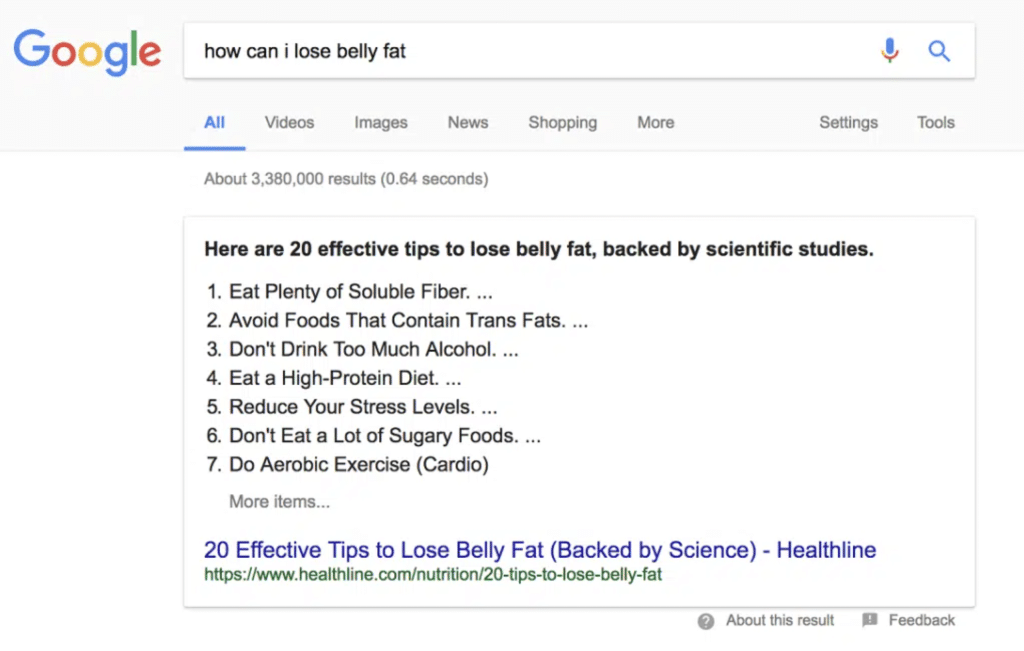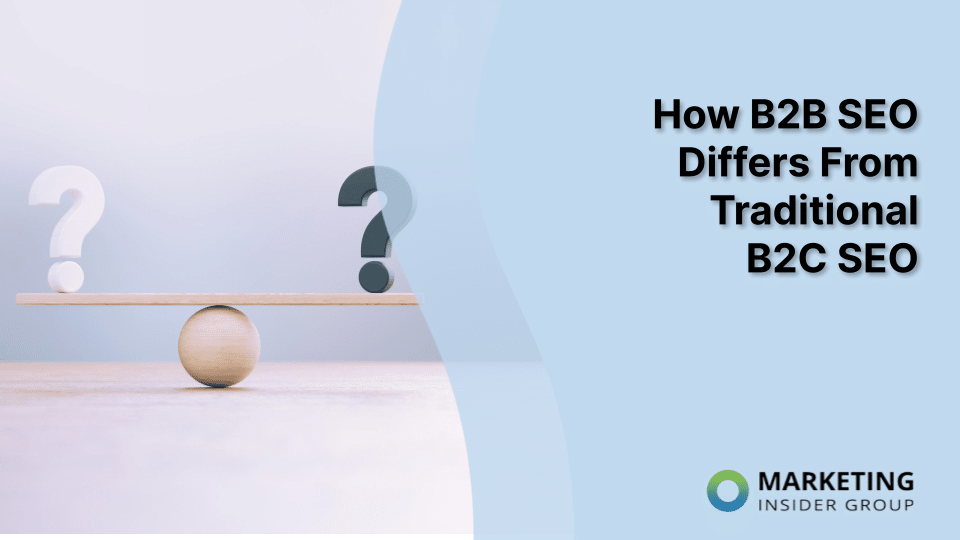
How Content Marketing Impacts Your SEO Rankings
Have you noticed how pretty much every brand is using content marketing for better SEO? It’s easy to see why. Just think about your own habits–whenever you need information, whether it’s business advice or hotel reviews, Google is usually the first stop.
It’s pretty clear that a lot of marketers are in on this. Many gauge their success by the amount of traffic their websites receive and acknowledge the critical role of SEO in content marketing.
But here’s the thing: Getting the hang of SEO in content marketing can be tricky. There’s no rulebook for navigating Google’s ever-changing guidelines and trying to understand the best ways to rank higher. It’s more like throwing a bunch of ideas out there and hoping something sticks.
The real trick to getting your content to rank is keeping up with what Google wants and taking notes on what’s working for others. It’s all about staying in the loop and trying out different stuff until you find what clicks for your brand.
Quick Takeaways:
- Quality content is one of the main factors in ranking high in searches for what you sell.
- Leverage content strategies that will partner with SEO to deliver the ultimate value to your customers.
- The higher value you bring to your audience, the higher you’ll rank in searches.
- SEO is vital for small businesses to enhance online visibility and compete effectively with larger companies by improving their search engine rankings.
- Measuring and analyzing SEO performance using tools like Google Analytics is crucial for understanding the impact of content marketing and refining strategies for better search engine rankings.
Understanding SEO for Small Businesses
SEO, or Search Engine Optimization, is a crucial tool for small businesses. In fact, 93% of online experiences begin with search engines like Google, highlighting the importance of staying on top of SERPs.

Image Source: WebFX
SEO helps your website show up higher in search engine results. This means more people can find your business online. But what exactly is SEO, and why is it so important for small businesses?
SEO involves making changes to your website so that search engines like Google can easily understand it. When your website is clear to these search engines, they rank it higher. This higher ranking is important because most people click on the first few links they see after a search. If your website appears there, more people will likely visit it.
For small businesses, SEO is especially important. You might not have a big budget for advertising like large companies. SEO offers a cost-effective way to reach more customers. It levels the playing field, allowing small businesses to compete with bigger ones.
Common SEO Challenges
However, small businesses often face unique challenges with SEO. You might have a smaller team, which means less time to focus on SEO. Or, you might not know where to start with making your website more search engine friendly. The good news is, even small steps can make a big difference.
The Evolving Landscape of SEO
The world of SEO keeps changing. In the past, it was mostly about using the right keywords. Now, it’s more about understanding what people are looking for – their intent. It’s not just about getting any visitors to your site, but the right ones. Those who are genuinely interested in what you offer.
Is Content Marketing Synonymous with SEO?
If you were to step back in time into a marketing conference from a decade or so ago, content marketing SEO would be the buzzword you’d hear on everyone’s lips.
But back then, content was only a vehicle for injecting keywords into blog posts and other website content. Lots of them. Because, you know, SEO. And if you didn’t stuff your content full of them, the divine bots wouldn’t grace your posts and web pages with the number one position in the search results.
Back then, the more keywords and the weirder you’d arrange them, the higher your site would rank. You know, stuff like “best software NYC” used just so. If you dared insert an “in” or a “for” to make it read less awkwardly, you’d get a nastygram from your SEO team.
As a result, it’s downright embarrassing to read awkwardly worded blog posts from that era that content teams haven’t taken the time to update. As an aside, that alone makes a great argument for doing content audits – and doing them often.
But thankfully, things have undergone a sea change since then. Although content marketing isn’t the new SEO, top-quality content is becoming the definitive factor in optimizing your site to rank high in Google searches.
And it’s not so much the keywords these days. It’s more about how you use them and related words in an article that’s so helpful to your target market that they share it with their friends and colleagues.
The Relationship Between SEO and Content Marketing: It’s Complicated
Video Source: Ahrefs
Search engine optimization (SEO) goes well beyond keywords these days. While several back-end factors help you rank better, such as page loading speed and mobile optimization, content has taken on new importance in an effective SEO strategy.
To rank at the top of search results, your content must be of such high authority that it attracts the attention of respected industry professionals. So much so that they link to it in their own content.
Links are the currency of today’s search engines, and only the most informative content earns enough links to catapult it to the top of search results for your chosen keywords.
Including structured data in your content, too, can land your site even above paid search, at “position zero.” Structured data – data organized in a manner that both computers and humans can recognize and access easily – has risen in importance for SEO.
Including images, lists, and other enhancements that answer user queries is an effective strategy, as is answering common questions people ask about your topic on voice searches. Include keyword-rich meta descriptions for your content and tags on your visuals.
Let’s take a look at some (okay, most) of the other go-to strategies recommended by top content marketing and SEO experts.
1. Create Original, High-Quality Content
Google’s algorithms are always looking for the highest quality content based upon the relevant terms that searchers are inputting. Google crawls through websites, and determines relevance based upon keywords that appear on them.
The search engine figures out whether a website is high-quality or not if other high-quality sites link to your website. Plus, it looks at the amount of engagement from users with your website, and how much content on your site is distinctive. Engagement means, are they clicking on you in a search engine and immediately returning to their search? Or are they staying on your page for a distinct amount of time and perhaps pursuing more content there?
Brandon Leibowitz of SEO Optimizers says that when it comes to content, marketers should focus on quality. “A lot of people want to put out as much content as possible. People are fixated on quantity, which is a 2012 SEO strategy.”
To start, Leibowitz suggests writing content for the benefit of the reader, and not fixating on SEO. You should use a relevant keyword in the title of your content, but don’t try and grab someone’s attention with clickbait. Instead, think about how you can answer a question relevant to your consumer base, while incorporating keywords relevant to your brand.
Writing long-form content, especially when you’re initially trying to rank high, is more effective than content that’s light on word count.
“Study after study has shown that long-form content performs quite well with Google as well as audiences,” says A.J. Ghergich, Founder of Ghergich & Co., a content marketing agency. When people are first starting out with content marketing on their blogs I actually encourage them to start with long-form content.”
In terms of length, Ghergich recommends 1,500 to 3,000 word posts that contain visual assets. These include images and video peppered throughout the content that are helpful to the readers.
Images and video are important because they decrease the likelihood of a person leaving your page quickly. If someone goes to your site and only browses for 30 seconds before leaving, and this occurs often, it means you might have a high bounce rate. Long form content that is broken up with visuals, headers, and bullet points will draw in your prospects.
2. Invest in SEO
Some content marketers think that they can achieve business results with a high ranking from organic linking and traffic, and discard the need to use paid promotion as well. In reality, both are required in order to succeed.
Whether you’re paying for a press release distribution service, taking out native ads on high-quality websites, or hiring an outside firm to handle your SEO, realize that all of these efforts are an investment in your company. There is only so far you can get with organic. Paid promotion has great potential to spread your company’s message and help you reach your core audience.
According to Ghergich, when looking into firms to help you boost your rankings, it’s important that you already know the bare bones of SEO. “You will make a much better hiring decision if you at least know the basics,” he says.
Moreover, it’s essential to note that organic search still plays a significant role, with 53% of businesses getting their overall web traffic from organic search. This highlights the need for a dual strategy encompassing both organic and paid channels to maximize reach and effectiveness.

Image Source: John Kramer
To avoid wasting your time and resources, before you sign up with a firm, ask to see examples of sites that the firm has gotten placement for their clients on in the past. “If your SEO agency can’t get you on sites like The Huffington Post they are doing it wrong,” says Ghergich.
3. Use SEO Keywords Smartly
Keywords need to appear within the title of your content, as well as in the body of it. While SEO used to be all about the keywords, it’s since expanded into broader territories. Still, keywords are very important.
To effectively utilize keywords, you must first do your research and find ones that’ll apply to your content. This must be an ongoing practice, and not something you do one time. Keyword popularity is always changing, and you have to keep up with it in order to rank high.
When deciding what keywords to use, brands can run free searches on sites like Keyword Tool. On it, you’re able to see which keywords are popular so that you can then integrate them into your content. WordStream, which provides ideas for keywords related to whatever keyword you input, is also useful. For example, if you type in “content marketing,” other popular keywords include, “original marketing content services” and “how big is a content marketing agency.”
You don’t want to use keywords too many times within your content, or else Google will think you’re spammy (so will your readers). If you don’t use them enough, Google won’t know what your site is about. SEO firm Bruce Clay recommends naturally using the keywords where they work best within your content and not forcing them in there.
However, a good rule of thumb is to include your keywords in the first 200 words of your content, and one time within the first 160 characters of the meta description of the page. Along with existing in your written content, keywords should be integrated within your optimized images. According to Content Marketer Jayson DeMers, your keywords need to be built into your logo and header images, as well as your buttons and graphics on your site in your alt image text.
4. Design for the User
If you want users to be engaged, you need to design your website so that it’s easy to navigate and user-friendly. Make sure that your site has:
- Good color contrast
- A sensible, logical order to it, i.e. navigation at the top and content below, calls to action at the end of content, attractive visuals
- Larger fonts
- Content in various divided sections
- An apparent search bar
- White space
Your site also needs to be responsive to all different types of devices such as laptops, tablets, and smartphones. This means that it resizes and adjusts itself to the device that it’s being viewed on. Mobile friendliness is key, because mobile devices are what many consumers use when deciding whether or not they’ll make purchases.
If you want users-on-the-go to click on your website link on Google, as well as spend a decent amount of time browsing through it, you should:
- Get your business to show up on the local search section, which appears near the top of Google and is easy to click. When you’re establishing or editing your business’ online listing, include your website, address, hours, and phone number.
- Make sure that your site is loading fast enough. According to one study, 64% of people expect pages to fully load within four seconds. People are impatient, especially on mobile devices, and won’t hesitate to go to a competitor if the website is faster.
PS – Check out our case study that shows how we helped one company double their leads!
5. Delete Duplicate Versions of Pages
Duplicate pages can be a big problem for your ranking. This is because the wrong page might get indexed, and Google will split link metrics between different versions of the page instead of attributing it only to one.
Duplicate pages can be caused by a number of factors. Perhaps you use them for click tracking or you provide a printer friendly version of your page on your website. To remedy this issue, canonicalize your duplicate pages by using a 301 redirect to the correct page. This is a tag you can place within your HTML code (“rel=”canonical”).

Image Source: AtOnce
If a few pages on your website are naturally similar, write more content on each of them. That way, they’ll be distinctive to Google and your site will receive more clicks all around.
6. Try Out Helpful Tools
There are a variety of tools on the web that can assist you with the search engine optimization process. Some of the best ones are:
- Buzzsumo, which shows you who the key influencers are within your niche. Simply type a keyword into the site, and it’ll let you know who creates content that is popular that includes that keyword. Once you pinpoint these influencers with high-quality pages, you can reach out in hopes of having them link back to your content.
- Google Search Console, an all-in-one platform that shows you if your content is Google ready and friendly.
- BrowserStack, a site where you can check out how your website looks on different browsers. If it doesn’t look good across the board, you then have to modify it.
- Google Trends, where you can view trending topics and stories. When there is a popular news item that you can relate to your company, jump on the opportunity to use the applicable keywords within your content.
- Alexa, where you can see the most popular sites on the web. There is a category section that allows you to narrow down your search. Once you know what the popular sites are, you can aim to have links placed on them.
- Seoptimer, which will do a free SEO audit of your website. Input your website address, and it’ll tell you where your strengths and weaknesses lie in regards to content, linking, keywords, images, headers, and social media links.
- Moz, is a great tool that I’ve used in the past to track our SEO success and learn new tools and tips.
7. Make Valuable Connections
You can produce great long-form content that is rich with images and links to credible websites. However, if you’re not actively promoting your content and seeking distribution on high-quality websites, it’s not going to be seen.
Aside from using Buzzsumo to locate and contact the influencers within your niche, you could:
- Send these influencers emails or social requests when your company makes an announcement or to share a great infographic or piece of content. Show influencers how this news or data could benefit their audiences.
- If these influencers are writers, pitch them on story ideas and offer interviews with your company’s thought leaders.
- Ask influencers if they accept guest posts on their own blogs. Write high-quality content for them and see if it’s possible to link back to content native to your website.
8. Keep an Eye on Your Page Loading Times
A slow loading time is going to lead to a high bounce rate whether users are on desktop computers or their mobile devices. Aside from following the aforementioned rules for mobile, there are some other strategies you can use to make sure your site quickly loads.
Start at Google’s PageSpeed Insights. On this site, you can type in the URL for your website and see what your load speed is, out of 100. Google will tell you what you need to improve to make your site load faster on mobile and desktop devices.
For example, they may recommend optimizing images for both platforms, as well as minifying HTML and CSS. The rules are generally the same for both mobile and desktop; the difference is just that you can have bigger images (20-100kb), flash, and more intricate designs on your desktop page.
9. Modify Your URLs
Along with putting keywords in the titles of your website’s content, Moz’s Rand Fishkin recommends placing them in your URLs as well.
When a person hovers over anchor text, he or she will see that the website is actually relevant based upon the URL. If there is no anchor text, then he or she will recognize the relevance within the text.
Plus, URLs show up on Google, and help people decide whether or not to click on your website. If the title matches the URL, they’re going to trust it and go to your website.
The URL should be short (50 to 60 characters or less) and as readable as possible. Avoid having anything but words and dashes within your URLs. A bunch of numbers, symbols, and random letters confuse people and discourage them from clicking. Even if the title of your content has words like “the,” “and,” or “a” in it, you don’t need to include them in the URL in order for it to still be coherent. Finally, don’t use too many folders (slashes) within your URL.
10. Your Money or Your Life: Do No Harm
Video Source: Polaris
Digital audiences have always depended on the honor system to ensure that the information they consume is factually accurate. With Google’s new “Your Money or Your Life” (YMYL) standards, content on the websites of news outlets, legal services providers, financial services companies, healthcare companies, and similar sites must undergo rigorous scrutiny to rank high in people’s searches.
Like the ancient physician Hippocrates advised, do no harm. Citing more than one expert helps to earn Google’s nod for content on these websites, as does referencing academic papers or other rigorous studies.
If you publish content that, if incorrect, could cause someone to lose money, their freedom, or their health, you have a problem. It pays to check, double-check, and triple-check. Not just for your content ranking’s sake, but for your users. Focus on providing your users with the highest value, and your content should pass muster with Google.
11. Organize Your Content into Categories and Themes
Video Source: Yoast
Google – and other search engines – try to put themselves in the shoes of someone searching for information about specific topics. Organizing your content into various categories helps searchers and search engines alike to find what they need quickly, as Semrush’s Ashley Segura points out.
If you click on over to my “Blog” page, you’ll find four headlines: Content Marketing, Marketing Strategy, Event Marketing, and Employee Activation. Someone looking for information about holding an event to market their product can click on the “Event Marketing“ headline and find relevant information without having to shuffle through our entire collection of blog posts.
12. Differentiate Your Content from That of Your Competitors
Image Source: Neil Patel
Instead of the “keeping up with the Joneses” routine of matching your competitors’ content move for move, see what you can do to make your content unique in your audience’s minds. Not only will this strategy offer your audience a different angle on your key topics, but it will also position you better in Google searches, provided you get specific.
The secret sauce that gives you the edge is finding your niche. Let’s say that you sell software-as-a-service (SaaS). Your competitors focus on providing businesses with software geared to their needs, but you notice a lot of schools and other educational institutions among your blog post readers and customer base.
Focus the lion’s share of content on how teachers and other school personnel can use your software solutions to streamline their workflow and make it easier for their students to learn. Use keyword strings, such as “software that ignites learning” as opposed to “software for organizations.”
Then, create content that educators can use to solve their problems, and you’ll soon find yourself ranking at the top of the heap in educators’ searches. Specificity and uniqueness are the keys to success in integrating SEO with your content strategy.
13. Refresh Your Content Often
It’s not only outdated posts that turn up in your content audits. It’s those evergreen posts with lasting power that could use a fresh coat of paint as well.
Search engines gobble fresh content like your fat uncle on Thanksgiving Day. So, it pays to go back into your content inventory and re-write, re-record, or re-film pieces that you haven’t touched in a while.
New content, too, helps. But we’re a big believer in recycling older content to get more mileage out of all that research your team put into it. You’ll rank higher in searches and give your audience fresh insights – which is one of the main reasons they frequent your site.
14. Understand the E-E-A-T Framework
Let’s dive a little deeper into what goes into producing content that gets Google’s attention while bringing value to your target customers. It all starts with a principle called E-E-A-T – experience, expertise, authoritativeness, and trustworthiness.

Image Source: Digital Resource
Without getting into the weeds of Google’s Search Quality Evaluator Guidelines, most of these guidelines boil down to those simple principles.
Experience
Experience isn’t just about the time you’ve spent in your field, but how you’ve applied what you’ve learned to real-world situations. This is where your content can truly shine.
Share stories of how your products or services have solved actual problems. These narratives not only engage your audience, but also demonstrate your hands-on knowledge and skills. Think of it as bringing your expertise to life. Instead of just talking about theories or concepts, show how they work in practice.
For instance, case studies or customer success stories are excellent ways to illustrate your experience. They provide concrete examples of how your knowledge and skills have been effectively applied, making your advice and solutions more relatable and trustworthy.
Remember, your audience is more likely to trust you if they see that you’ve successfully navigated challenges similar to theirs. By sharing these experiences, you’re not just telling your audience that you know what you’re talking about; you’re showing them.
This approach not only reinforces your credibility, but also makes your content more engaging and valuable to your readers, further enhancing your website’s SEO.
Expertise
Showcasing your expertise with content doesn’t mean braggadocio. Quite the opposite.
People buy your products and services because they provide them with a benefit. The more expertise you have in your field, the better products you’ll make.
Like your high school English teacher always told you, “Show, don’t tell.” Demonstrate your broad knowledge of your industry with thought-provoking content that helps your target customers solve problems, become better informed, or learn to do something new.
Approach your content like an effective teacher. Explain concepts in the simplest language possible.
You might think that highly technical jargon will make you sound like an expert, but it doesn’t. Breaking down complex topics into easily understandable chunks is the sign of a true expert.
When you do mention your products, position them as the tools that will help your customers solve a problem they face. Don’t play the hero with either your products or your expertise. Let the customer be the conquering hero.
Providing new information, helpful tips, and instructional material also does something else. It makes your content more shareable, more link-worthy, doubling down on your content’s SEO value.
Authoritativeness
Authoritativeness gauges your reputation in your industry. When you become the definitive source that people turn to for reliable information about topics you have expertise in, you have authority in your field.
Google looks at reputation from both a user’s and industry influencers’ perspectives. If other prominent names in your industry cite your articles in their content, it places you in a position of authority. Similarly, if you provide helpful information to users, your authority will rise.
So, you’ll want to create thought leadership content that others in your industry or related industries will find valuable. At the same time, publish content that users can turn to for valuable advice.
The more content you produce that hits these targets, the more Google – and your target audience – will consider you an authority in your industry.
Trustworthiness
Trustworthiness is connected to the accuracy, transparency, and legitimacy of your content. First of all, the more contact information you have on your website as a whole, the better. Here’s why.
If someone has questions about your business or the content itself, they need to be able to contact you through the method most convenient to them. For instance, if you only have an email address, it would be a hassle for someone on a mobile phone to click away from your website to their email provider. Having a clickable phone number available makes it easier to get in touch while they are still on your site.
Your content must also be accurate and related to your website’s purpose. Make sure your content covers these bases:
- Accuracy: Using several reputable sources to support your conclusions undergirds your content with documentation.
- Relevancy: If I were suddenly to veer off and write an article about baseball, it wouldn’t be relevant to my audience or the rest of my website – unless I could tie it back to content marketing with a clever analogy. However, since my audience comes to my site to learn about content marketing, articles about all things content marketing are relevant – and Google recognizes them as such.
15. Fuel Your SEO With Pure-Value Content Marketing
A study conducted by Moz showed that higher traffic and greater levels of engagement correlate to improved search engine rankings. So regardless of a site’s traffic sources, the more you can improve its visibility, the better it may perform in Google search.
For most professionals engaged in SEO, regular blogging and content marketing has become best practice. However, many SEO-driven content marketing strategies are too focused on keywords and search engine manipulation. To cultivate greater success with content marketing, put human-centric, thought leadership content on the forefront.
What defines “pure-value content?” From a search-first content marketing perspective, instead of writing generic, keyword-optimized articles on topics like How to Hire an ‘Atlanta DUI Lawyer’, a pure-value approach would sound more like Can You Beat DUI Conviction in Georgia?

Image Source: Smart Insights
In essence, you can still make the content keyword-relevant and optimized for SEO, but with an emphasis on being more educational, informative, and solution-oriented. Whether as a video, in-depth article, or infographic, a pure-value piece of content on such a legal topic will most certainly address a common question among many individuals. Further, such content will have greater potential to drive traffic and enduring levels of engagement.
16. Find the Optimum Length for Your Content
The perfect blog post length is a controversial topic. I’ve done my fair share of guest posting, and I’ve seen guidelines specifying everything from 500 to 2500 words minimum.
Unfortunately, regularly churning out 2500 word, high-quality blog posts is too demanding for most small businesses. Instead, shoot for around 1000 words. This gives you the scope to create a quality blog post, and won’t eat into too much of your time.

Image Source: Character Counter
The more words, the better of course. But if you can’t manage more, don’t obsess over it. Aim for no less than 500 words as a minimum, and your content will still be readable and rankable.
It’s worth mentioning your title length here too. A clickable blog title drives traffic (e.g. “10 SEO Trends You Need To Know In 2019”), which in turn signals to search engines that it’s worth ranking. Your titles should also be between 50-60 characters long to display fully on SERPs.
Remember, your title tags, meta description, and URL all play a part in improving your content SEO. If that sounds daunting, don’t be put off. The Yoast plugin for WordPress makes it easy to optimize your tags and descriptions with intelligent keyword planning.
Plus, as WordPress integrates with most reliable online store creators, you can start optimizing your blog’s SERP data with whichever ecommerce platform you use. It’s a versatile blogging solution that makes it easy for small businesses to enhance their SEO, perfect for novices or experts.
1000 words is a good rule of thumb, but don’t sweat it too much. Quality is important, and an amazing 500 word blog post is better than a terrible 2500 word one. And don’t be afraid of bulking it out with some images and video either — it’s great for your readers, and great for your SEO too.
17. Embrace Local SEO
Local SEO is your small business’s secret weapon in the battle of the SERPs. It’s vital in a mobile-first market and will both net you sales and drive traffic.
Of course, local SEO won’t work for every small biz. If you own an online store and your customers come from all over the globe, locality won’t necessarily affect your sales. But for those small businesses that deal with face-to-face transactions, local SEO is an absolute must.
Beyond optimizing your website for local SEO, you should create a blog content strategy that addresses and explores local issues. When you write about regional places and events, search engines pick up on it and increase your ranking in local search queries.
Identify the local keywords that relate to your small biz: your state, town or city, even your borough or street. Next, pick out local issues such as cultural events or news and write blogs about them.
18. Increase Visibility & Interaction with Social Media
Even for the businesses and brands with thousands of social media followers, there’s significant value in leveraging social media advertising on Facebook, Twitter, LinkedIn, Pinterest, etc. On these social media platforms, you can get exposure in front of new audiences based on specific interests and psychographics, demographics, and geographics.

Image Source: Smart Insights
For example, an attorney could advertise its content on How Beat DUI Charges in Georgia by targeting individuals located in Atlanta between the ages of 18-45. Not only can the criminal defense lawyer earn new social media followers in the process, but he could drive in-market traffic to his website.
In addition to improving site traffic and engagement, the piece of content can rack-up social signals (i.e. tweets, likes, +1’s, shares, etc.) While Google has yet to confirm any influence of social signals over its rankings, countless search marketers will debate that social signals do have a positive impact on SEO and higher rankings.
This may or may not be a result of the content earning links naturally as result of its popularity on social media platforms. Or it could be an emerging and unannounced ranking signal that has yet to come to publicized. Regardless, social media can dramatically help start-jump SEO, especially when driven by pure-value content marketing and strategic utilization of social advertising platforms.
19. Keep Generating New Topic Ideas
Struggling for inspiration for a blog post that ranks? Thankfully, there’s a number of useful tools to help you identify relevant blog post topics to write about that let you search for current popular content based on your business keywords and identify trending topics related to your industry.
Simply use these trending topics as inspiration for your own strategy, and you’ll have superb blog content that your customers — and the search engines — will love.
The key to a successful ranking blog strategy is fresh and current content. Update yours regularly with content that addresses trending events and issues. It’s good for your SEO, great for your customers, and it positions your small business as modern and relevant too.
20. Don’t Neglect Image SEO
Did you know that the images and videos that you use in your blogs also affect your SEO? Last year, Google updated its image search function, including providing the option to filter results by theme.
For example, an image search for “cats” could be further sorted by categories such as: anime, baby, kitten, white, wallpaper, and so on. Consequently, those blogs that contain search engine optimized-images will be favored by Google’s crawlers.
Beyond that, having images or video in your blog increases your reader’s time on site, and generally enhances their experience of your website. Choose high-quality images and optimize their alt tags with relevant keywords. And avoid massive photos that take too long to load which will negatively impact your SEO.
It goes without saying that original photos will always trump generic stock photos. But as a small biz owner, finding the time to take high-quality original snaps is tricky. So while generic stock photos are a no-no, there are some websites that offer quality free images for download that actually look and feel unique. Use a free online photo editor to give them a creative spin and truly make them your own.
21. Make the Most of Featured Snippets
Google is increasingly keeping its users on the SERPs through the use of featured snippets. These are the text boxes that appear at the top of results pages, answering queries and often preventing people from clicking through to a website.
For small businesses, this is both good and bad. In many cases, a searcher might get the answer they need and not visit your website as a result. But savvy businesses use featured snippets to pique their visitor’s interest, compelling them to click through.

Image Source: Google
As with most things, it’s better to swim with the tide than against it, so it’s important that you optimize your blog content for these snippets where appropriate.
If you’re writing a blog that answers a query (think evergreen content and essential guides), make it high-quality and comprehensive. Maybe that’s a given, but you should also format it in a way that works for Google. This is a multi-pronged task, so find out exactly what this entails here.
22. Use Other People’s Content
Another point worth addressing… When it comes to syndicated or licensed content, we often first see fear in the eyes of our customers.
Turns out, the massive and nearly ubiquitous myth in certain marketing circles and across the interwebs is that duplicate content hurts SEO. Some believe that duplicate content can actually cause a brand to be penalized. This myth has been around a long time. And in our customer strategy work, it comes up all the time.
But is there any truth to it? And maybe more importantly, how can a brand use “other people’s” content to rise to the top of search engine rankings without breaking the bank?
The straight answer is that licensed or syndicated content doesn’t hurt a brand’s SEO at all. And it often helps SEO.
Don’t take our word for it, here is Google’s own take: “Let’s put this to bed once and for all, folks: There’s no such thing as a ‘duplicate content penalty.’
Duplicate content on a site is not grounds for action on that site unless it appears that the intent of the duplicate content is to be deceptive and manipulate search engine results.
I am a big fan of “other people’s” content.
At SAP, I built an award-winning content marketing hub called Business Innovation and started it with little budget. How do you build a content hub on a small budget? You need an army of volunteer content contributors.
I did this by syndicating content from other experts (mostly employees to start) with their permission. When I started showing business results and my budgets increased, I added licensed content as well as additional paid original content.
Many publishers offer great examples of high-volume sites built off a licensed-content approach. Even the top publisher sites in the world license images and stories from providers like Getty Images, Reuters, and Associated Press.
One of the reasons these sites rank for the topics they cover is that they produce a steady stream of content around their topics. Each licensed article adds a small amount of search authority on the topic.
23. Gain Search Authority with Volume, Value, and Variety
To break through the noise, brands need to focus on the 3Vs of content marketing:
- Volume: To achieve the highest level of organic search, brands need to start with the highest volume possible. To become an authority on a topic, you have to spend a lot of time (frequency) publishing on that topic. To rank higher than another source, you need to publish more content than the other source, all other things being equal.
- Value: As Lee Odden and Andy Crestodina have said, you need to create the best answer and the best pages on the internet for the topics relevant to your brand. Many marketers mistakenly think this means that you need to only publish articles greater than 1,000 words or some other arbitrary number. Long-form content should be part of the mix. But brands should also link to other sites with authority. Repurposing content or linking to other authorities on a topic is often the best way to provide value to your audience.
- Variety: The search engines report results in the form of web pages, images, videos, news, and more. To rank for a topic, brands need to create a variety of content types at a high enough volume and with relative value to be considered an authority.
Remember that building search authority takes time. This was the lesson my former SAP colleague, Gurdeep Dhillon, posted on LinkedIn. He found that it took about six months for search traffic on its Customer Edge site to reach close to 30%. The site includes the mix of content we recommend: original stories plus licensed content.
24. Use Your Content Marketing Budget Wisely
We should start by acknowledging that if budgets were limitless, brands would create mostly original content to give the best and unique answers on the internet in every format used by their audiences. But budgets at most brands are limited. So how do we achieve the best results with our content budget?
One approach I see brands taking often is the “rule of thirds,” stating that one-third of your content should be original, one-third licensed, and one-third community-generated. We don’t know what the right mix is for every brand. We only know that there needs to be a balance between cost and content effectiveness.
Starting with “the rule of thirds” allows you to test what works for your brand and its goals, then adjust the mix as you go. We often see that each type of content supports the other in gaining organic reach, social shares, and community engagement – all driving to better business outcomes.
Measuring the Impact of Content Marketing on SEO
As of 2023, 86% of B2B marketers use content marketing as a strategy. But to truly understand how your content marketing efforts are boosting your SEO, you need to measure and analyze the results.

Image Source: Zipdo
This process helps you identify what’s working and what needs improvement. By tracking your SEO progress, you can make informed decisions to enhance your content strategy and, ultimately, your website’s visibility in search engine results.
Key Tools and Metrics for SEO Tracking
Several tools are available to help you track your SEO progress. Google Analytics is one of our personal favorites, providing insights into your:
- Website traffic
- User behavior
- Conversion rates
Google Search Console is another essential tool that helps you understand how Google views your site and shows the keywords driving traffic to your pages.
When measuring SEO success, focus on key metrics such as:
- Organic Traffic: The number of visitors coming to your site through search engines.
- Keyword Rankings: The positions of your targeted keywords in search results.
- Bounce Rate: The percentage of visitors who leave your site after viewing only one page.
- Conversion Rate: The percentage of visitors who take a desired action on your site, like signing up for a newsletter or making a purchase.
- Page Load Time: How quickly your web pages load, which can impact user experience and SEO.
- Backlinks: The number and quality of external sites linking to your content.
Analyzing SEO Performance with Content Marketing
To specifically measure the impact of content marketing on SEO, look at how your content is performing in terms of engagement and rankings.
Are your blog posts or articles ranking for their targeted keywords? Is your content being shared on social media or linked to by other websites? These are signs that your content is valuable, relevant, and has a positive impact on your SEO.
Ready to Rule the Ranks on Google?
SEO for small businesses might seem tricky, but the methods we’ve talked about really do help with getting noticed online. By using these tips in your content strategy, you’re more likely to reach the people you want to, connect with potential customers, and draw them into what you’re selling.
Ready to rule the ranks on SERPs? Check out our SEO Blog Writing Service or schedule a quick consultation to learn more about how Marketing Insider Group can help you earn more leads for your business.






